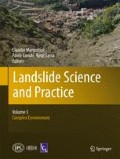Abstract
This study conducted landslide susceptibility mapping around the West margin active fault of western Niigata Prefecture, Japan using a logistic regression model. The result showed that 84.5 % of the pre-existing landslide topographies of the study area is low susceptibility, and 11.8 % of the study area is medium susceptibility, and only 3.7 % high susceptibility.
Access this chapter
Tax calculation will be finalised at checkout
Purchases are for personal use only
References
AIST (2009) Active fault database of Japan, June 23, 2009 version, Research information database DB095. National Institute of Advanced Science and Technology, http://riodbo2.ibae.go.jp/activefault/index_e.html
Akahane S, Kato H (1989) Geology of the Takada-seibu district, with geological map sheet at 1:50,000, Geological Survey of Japan, 89p (in Japanese with English abstract)
Ayalew L, Yamagishi H (2005) The application of GIS-based logistic regression for landslide susceptibility mapping in the Kakuda-Yahiko Mountains, Central Japan. Geomorphology 65:15–31
Chang KT, Chiang SH, Hsu ML (2007) Modeling typhoon-and earthquake-induced landslides in a mountainous watershed using logistic regression. Geomorphology 89:335–347
Garcia-Rodriguez MJ, Malpica JA, Benito B, Diaz M (2008) Susceptibility assessment of earthquake-triggered landslides in El Salvador using logistic regression. Geomorphology 95:172–191
Guzzetti F, Carrara A, Cardinali M, Reichenbach P (1999) Landslide hazard evolution: a review of current techniques and their application in a multi-scale study, Central Italy. Geomorphology 31: 181–216
Hasi B, Ishii Y, Maruyama K, Terada H, Suzuki S, Nakamura A (2011a) Distribution and scale of landslides induced by recent reverse-fault earthquakes in Japan. J Jpn Landslide Soc 48(1):23–38
Hasi B, Maruyama K, Nakamura A, Noro T (2011b) Statistical analysis of deep-seated landslides induced by recent strong earthquakes in eastern Japan: an approach based on pre-existing landslide topography, this issue
Inoue F, Imamura T (1999) Takada earthquake (1751) and slope disasters of Jyoetsu coast, JESE meeting of 1999, pp 290–291
NIED (2011) Landslide topography data base. http://lsweb1.ess.bosai.go.jp/index.html. Accessed 24 April 2011
Suzuki S, Has B, Maruyama K, Ishii Y (2010) Risk evaluation of earthquake-induced landslide based on analysis of erosion condition on landslide marginal part. In: Chen Su-Chin (ed) Interpraevent2010-symposium proceedings, pp 898–901
Tatsuo U (2001) Materials for comprehensive list of destructive earthquakes in Japan, latest edition. University of Tokyo Press, Tokyo, 416p
The Headquarters for Earthquake Research Promotion (2010) Long term assessment for Takada Plain active faults. http://www.jishin.go.jp/main/chousa/katsudansou_pdf/102_takada-heiya.pdf
The Headquarters of Earthquake Research and Promotion (2011) Long-term evaluation of active faults. http://www.jishin.go.jp/main/p_hyoka02_danso.htm#102
Acknowledgements
The authors would like to thank Dr. Edwin L. Harp for patient review and helpful suggestions that helpful to improve the paper.
Author information
Authors and Affiliations
Corresponding author
Editor information
Editors and Affiliations
Rights and permissions
Copyright information
© 2013 Springer-Verlag Berlin Heidelberg
About this chapter
Cite this chapter
Nakamura, A., Hasi, B., Noro, T., Maruyama, K. (2013). Susceptibility Mapping of Deep-Seated Landslides Around Active Fault System, a Case Study of Western Niigata, Japan. In: Margottini, C., Canuti, P., Sassa, K. (eds) Landslide Science and Practice. Springer, Berlin, Heidelberg. https://doi.org/10.1007/978-3-642-31427-8_32
Download citation
DOI: https://doi.org/10.1007/978-3-642-31427-8_32
Published:
Publisher Name: Springer, Berlin, Heidelberg
Print ISBN: 978-3-642-31426-1
Online ISBN: 978-3-642-31427-8
eBook Packages: Earth and Environmental ScienceEarth and Environmental Science (R0)

